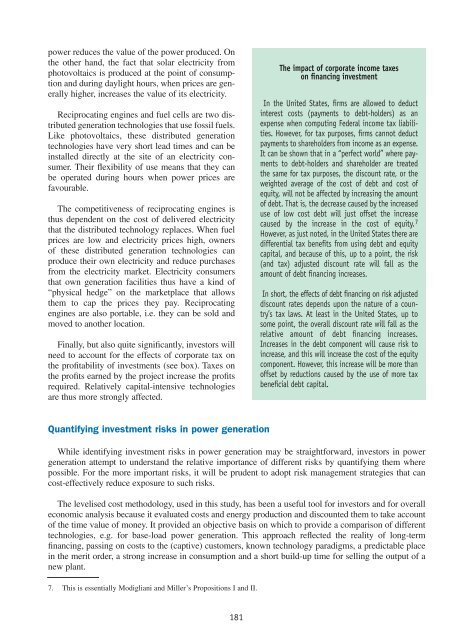Projected Costs of Generating Electricity - OECD Nuclear Energy ...
Projected Costs of Generating Electricity - OECD Nuclear Energy ...
Projected Costs of Generating Electricity - OECD Nuclear Energy ...
Create successful ePaper yourself
Turn your PDF publications into a flip-book with our unique Google optimized e-Paper software.
power reduces the value <strong>of</strong> the power produced. On<br />
the other hand, the fact that solar electricity from<br />
photovoltaics is produced at the point <strong>of</strong> consumption<br />
and during daylight hours, when prices are generally<br />
higher, increases the value <strong>of</strong> its electricity.<br />
Reciprocating engines and fuel cells are two distributed<br />
generation technologies that use fossil fuels.<br />
Like photovoltaics, these distributed generation<br />
technologies have very short lead times and can be<br />
installed directly at the site <strong>of</strong> an electricity consumer.<br />
Their flexibility <strong>of</strong> use means that they can<br />
be operated during hours when power prices are<br />
favourable.<br />
The competitiveness <strong>of</strong> reciprocating engines is<br />
thus dependent on the cost <strong>of</strong> delivered electricity<br />
that the distributed technology replaces. When fuel<br />
prices are low and electricity prices high, owners<br />
<strong>of</strong> these distributed generation technologies can<br />
produce their own electricity and reduce purchases<br />
from the electricity market. <strong>Electricity</strong> consumers<br />
that own generation facilities thus have a kind <strong>of</strong><br />
“physical hedge” on the marketplace that allows<br />
them to cap the prices they pay. Reciprocating<br />
engines are also portable, i.e. they can be sold and<br />
moved to another location.<br />
Finally, but also quite significantly, investors will<br />
need to account for the effects <strong>of</strong> corporate tax on<br />
the pr<strong>of</strong>itability <strong>of</strong> investments (see box). Taxes on<br />
the pr<strong>of</strong>its earned by the project increase the pr<strong>of</strong>its<br />
required. Relatively capital-intensive technologies<br />
are thus more strongly affected.<br />
The impact <strong>of</strong> corporate income taxes<br />
on financing investment<br />
In the United States, firms are allowed to deduct<br />
interest costs (payments to debt-holders) as an<br />
expense when computing Federal income tax liabilities.<br />
However, for tax purposes, firms cannot deduct<br />
payments to shareholders from income as an expense.<br />
It can be shown that in a “perfect world” where payments<br />
to debt-holders and shareholder are treated<br />
the same for tax purposes, the discount rate, or the<br />
weighted average <strong>of</strong> the cost <strong>of</strong> debt and cost <strong>of</strong><br />
equity, will not be affected by increasing the amount<br />
<strong>of</strong> debt. That is, the decrease caused by the increased<br />
use <strong>of</strong> low cost debt will just <strong>of</strong>fset the increase<br />
caused by the increase in the cost <strong>of</strong> equity. 7<br />
However, as just noted, in the United States there are<br />
differential tax benefits from using debt and equity<br />
capital, and because <strong>of</strong> this, up to a point, the risk<br />
(and tax) adjusted discount rate will fall as the<br />
amount <strong>of</strong> debt financing increases.<br />
In short, the effects <strong>of</strong> debt financing on risk adjusted<br />
discount rates depends upon the nature <strong>of</strong> a country’s<br />
tax laws. At least in the United States, up to<br />
some point, the overall discount rate will fall as the<br />
relative amount <strong>of</strong> debt financing increases.<br />
Increases in the debt component will cause risk to<br />
increase, and this will increase the cost <strong>of</strong> the equity<br />
component. However, this increase will be more than<br />
<strong>of</strong>fset by reductions caused by the use <strong>of</strong> more tax<br />
beneficial debt capital.<br />
Quantifying investment risks in power generation<br />
While identifying investment risks in power generation may be straightforward, investors in power<br />
generation attempt to understand the relative importance <strong>of</strong> different risks by quantifying them where<br />
possible. For the more important risks, it will be prudent to adopt risk management strategies that can<br />
cost-effectively reduce exposure to such risks.<br />
The levelised cost methodology, used in this study, has been a useful tool for investors and for overall<br />
economic analysis because it evaluated costs and energy production and discounted them to take account<br />
<strong>of</strong> the time value <strong>of</strong> money. It provided an objective basis on which to provide a comparison <strong>of</strong> different<br />
technologies, e.g. for base-load power generation. This approach reflected the reality <strong>of</strong> long-term<br />
financing, passing on costs to the (captive) customers, known technology paradigms, a predictable place<br />
in the merit order, a strong increase in consumption and a short build-up time for selling the output <strong>of</strong> a<br />
new plant.<br />
7. This is essentially Modigliani and Miller’s Propositions I and II.<br />
181

















